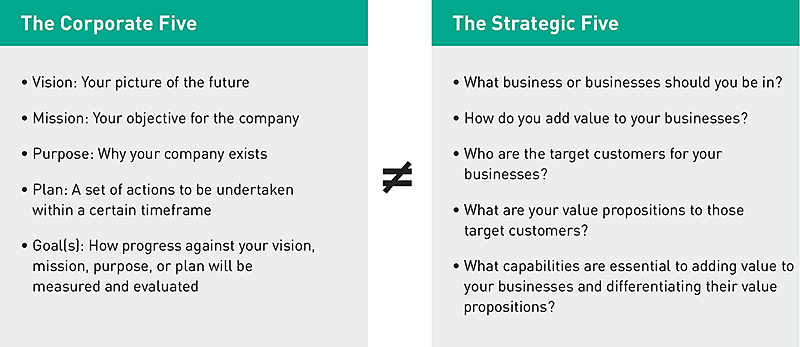How Leaders Mistake Execution for Strategy (and Why That Damages Both)
When leaders substitute visions, missions, purposes, plans, or goals for the real work of strategy, they send their firms adrift.
When discussing strategy, executives often invoke some version of a vision, a mission, a purpose, a plan, or a set of goals. I call these “the corporate five” Each is important in driving execution, no doubt, but none should be mistaken for a strategy. The corporate five may help bring your strategy to life, but they do not give you a strategy to begin with.
Nevertheless, they are often mistaken for strategy—and when that happens, real damage can ensue. If the corporate five are the cart and strategy is the horse, leaders who put the cart first often end up with no horse at all.
Before they get to the corporate five, companies need to address five much more fundamental, and difficult, questions. Let's call them the “the strategic five”:
1. What business or businesses should you be in?
2. How do you add value to your businesses?
3. Who are the target customers for your businesses?
4. What are your value propositions to those target customers?
5. What capabilities are essential to adding value to your businesses and differentiating their value propositions?
Although most companies can articulate a vision (for instance, “to be the leading biotech company”), a mission (“to find and commercialize innovative drug therapies”), a purpose (“to improve patients’ lives”), a plan (“to develop molecule X, enter market Y, and partner with company Z”), or a goal (“to bring three innovative molecules to market by 2025”), few convincingly answer all five strategic questions, especially with one voice across their top teams and down their organizations.
They can’t answer those questions because often they haven’t asked them in a very long time, if at all. Instead, the corporate five have become a mask for strategy. When that happens, the real substance of strategy—making deliberate and decisive choices about where to play and the way to play—is lost. There is no foundation for decision making and resource allocation. Everything becomes important. Indiscriminate cost-cutting and growth become the order of the day and, sooner or later, with no strategy as a guide, a business drifts. Consider Procter and Gamble. It has a mission (“to touch and improve the lives of more consumers, in more parts of the world, more completely”) and a CEO who says he is “totally focused on the plan.

IBM, on the other hand, is an example of getting it right. When Lou Gerstner took over the reins of the troubled company in 1993, he famously declared, “The last thing IBM needs right now is a vision.” This was widely interpreted as a statement that execution would be the priority and strategy would take a backseat, at least while Gerstner was busy turning around the company. But he proceeded to redefine IBM’s business boundaries (from computer hardware to hardware, software, and services), value proposition (from best products to corporate solutions), and essential capabilities (for example, from selling to the IT department to selling to the C-suite). In other words, he focused on the strategic five—not the corporate five—to make his elephant dance. Gerstner was as strategic a CEO as they come. James E. Burke, former CEO of Johnson & Johnson and former IBM board director, said of him, “He thinks strategically about everything. I once asked him if he thought strategically about his dog.” Gerstner knew that IBM was suffering from a lack of clear and coherent strategic choices and that fixing this was far more important to the company’s immediate needs than was envisioning the company’s longer-term future. Without the former, there would be no need for the latter.
